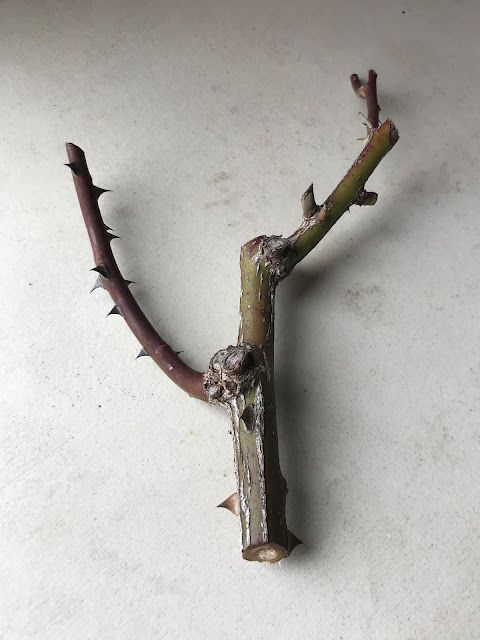 |
| Crown Gall growing on Tournament of Roses |
Agrobacterium
tumefaciens and your roses
Joe Truskot, Master Rosarian
Basic
Questions
What are galls?
Outgrowths of
plant tissue, Reprogrammed cells, Tumors, Not parasitic growths like mistletoe
What causes galls to form on many plants?
Insects including wasps, aphids, flies, various fungi,
bacteria and viruses
What causes galls to form on roses?
Bacteria in the soil, Agrobacterium tumefaciens
Which roses are most susceptible?
Roses in the ground for more than 3 seasons, grafted
roses (more so than own root), bare root roses with broken prominent roots, dug
up and transplanted roses
How do the bacteria enter the bush?
Weak grafts, injured roots, frost damage, and, unintentionally,
moles other ground diggers
What are the signs of a crown gall infestation?
Decreasing
performance, fewer basal breaks or strong canes, decline in candelabras
or flower sprays,
Small/spindly canes from the bud union, lack of normal
vigor, sudden death of major canes, food/water/ sunshine – don’t help
 |
| Stem gall on a rose cane and root gall on lower root |
Options and Remedies
Do nothing.
No cure - but it grows slowly, too late for amputation, vigorous
roses will live for years with it, hardened galls are safe houses for earwigs
and insect larvae
Do surgery.
Sharpen your hatchet, scrape down to the greenwood, disinfect
with vinegar, alcohol or bleach solutions
Dig up and discard.
Remove affected plant/galls/soil, salvage what you can, make
cuttings in fresh soil, add plenty of green manure to the area, plant annuals and cereal grasses from seed, let
2 or 3 years go by before planting roses in that spot
Biological Control.
Galltrol uses a strain of freshly grown Agrobacterium radiobacter
Commercially
available Gallex.
Dig all around the base and discard soil, remove as much
of the gall as possible, leave exposed for two days, paint on the Gallex and
let dry for 2 days, replace with fresh soil
Buy a new rose.
Prepare new roses.
Soak bare root
roses in a weak bleach solution (1/4 cup bleach to 5 gallons of water),
kills surface bacteria/insect eggs, rehydrates the bush
Remove Bindweed.
Wild morning glory can serve as a host (bindweed, Ipomoea
leptphylla), birds eat the fruit and scatter the seeds, bacteria clings to
bindweed roots
Help the rose
defend itself.
When injured,
plants release phenolic compounds. Phenols are sent to the injured area
to heal the wound. Most plant scars are a result of the phenols in action.
Hungry, thirsty roses can’t produce enough phenols.
Where do phenols
exist?
Phenols are
present in the food we eat, found in plants used in traditional medicine,
some phenols are germicidal and used in disinfectants
 |
| Healthy soil is inviting to surface critters as well as earthworms, grubs and a panoply of microbes below ground |
Components of Healthy Soil
Sandy loam:
Good drainage, adequate air circulation, easy for rose
roots to grow, composition is 50-70% sand, 15-20% clay, and 15-20% silt
Organic material:
Controls pH factor, provides nutrients, retains moisture
Microbial action:
Breaks down organic material, provides environment for
earthworms, warms the soil, certain
bacteria and fungi help a rose’s immune system, protect against
pathogens and other threats, fungi colonize plant roots and create mycorrhizae
which greatly extend the reach of the roots
Microbes in
Healthy Soil:
Part of a rose’s digestive system, recycle water and
break down nutrients, overuse of chemical fertilizers and pesticides harms
microbes
What do
mycorrhizae do?
Mycorrhizae help similar plants communicate, produce
chemicals that repel pests and attract predatory insects, mycorrhizae are
covered with a protein called glomalin which is composed of 30 to 40 % carbon.
Glomoalin fixes carbon in the soil. Ninety percent of all organisms on the
planet live underground.
What are bacteria?
One-celled microscopic organisms are oblong and rod-like,
one teaspoon of healthy soil contains from 100 million to 1 billion bacteria, bacteria
dots the surface strands of fungi
What are the four
bacteria groups?
Decomposers: convert energy in soil organic matter
into forms other organisms can use
Nitrogen
fixers: from air to
soil
Chemoautotrophs: obtain energy from other than carbon
(nitrogen, sulfur, iron, hydrogen)
Pathogens: includes Agrobacterium tumefaciens
which create galls
What do bacteria
do?
All four groups of bacteria help water retention and the
movement of water in soil, nitrogen fixing: from air to soil, nitrifying:
converting ammonia to nitrite, denitrifying: anaerobic (water-logged
soil) release nitrogen, release stored energy in the form of heat
What are
actinomycetes?
More highly evolved than bacteria but not quite a fungus,
best at hard to degrade cellulose and chitin at high pH levels, the smell of
healthy organic soil means actinomycetes are present
What are the
benefits of Agrobacterium tumefaciens?
Scientists have converted (“disarmed”) it into
efficient delivery systems for genetic manipulation. The transgenes must be
stably integrated in the host genome. Agrobacteria largely modify the host,
particularly its defense-related genes. Agrobacteria largely shift the “hormone
balance” in their infected hosts. This effect on endogenous growth regulators
will ultimately lead to agrobacterium-induced tumor formation. This property
makes genetic modification possible















